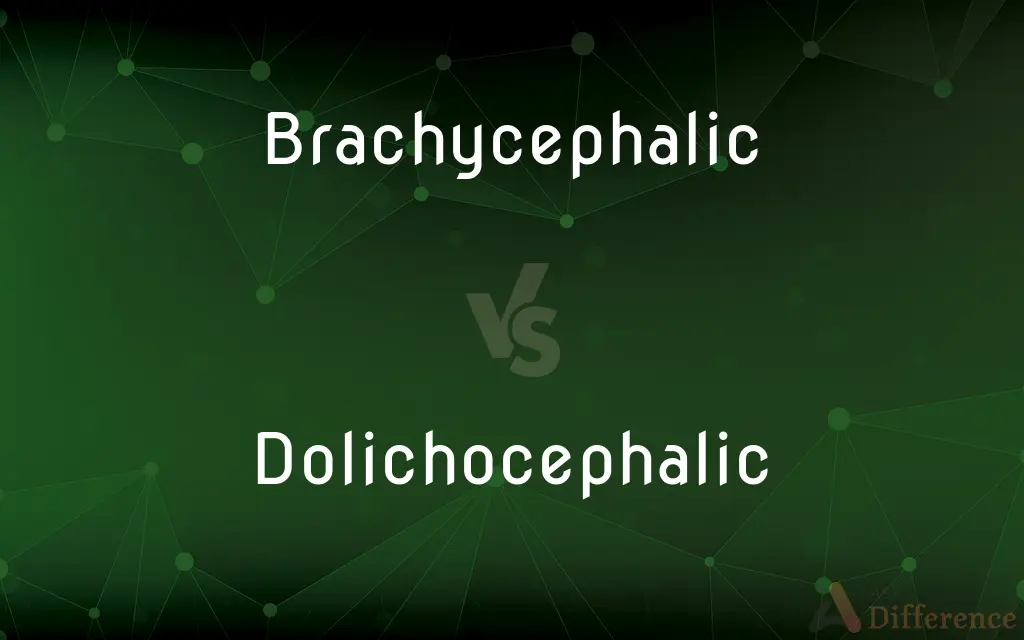Brachycephalic vs. Dolichocephalic — What's the Difference?
By Maham Liaqat & Urooj Arif — Updated on March 25, 2024
Brachycephalic describes a short, wide head shape, common in certain dog breeds and affecting human skull shapes, while Dolichocephalic refers to a long, narrow head, seen less frequently in dogs and characteristic of some human populations.

Difference Between Brachycephalic and Dolichocephalic
Table of Contents
ADVERTISEMENT
Key Differences
Brachycephalic skulls are characterized by their shortness in length relative to their width, leading to a broader facial appearance. This trait is notable in breeds like Bulldogs and Pugs. Dolichocephalic skulls, however, are longer than they are wide, giving a more elongated facial structure, as seen in breeds such as Greyhounds.
In humans, brachycephalic conditions can lead to health issues, such as breathing difficulties in brachycephalic dog breeds due to compressed nasal passages. Dolichocephalic humans generally do not face such health concerns related to skull shape, though the classification has historical significance in anthropological studies.
The brachycephalic head shape affects the positioning of teeth and jaw, often resulting in dental crowding and related issues. In contrast, dolichocephalic heads may have more space for teeth, potentially affecting dental health differently.
Cultural and historical perspectives on head shapes have varied, with some societies historically preferring one shape over the other for aesthetic or symbolic reasons. Today, understanding these head shapes is important for medical, veterinary, and anthropological fields.
Comparison Chart
Definition
Short and wide head shape
Long and narrow head shape
ADVERTISEMENT
Common In
Bulldogs, Pugs, and some human populations
Greyhounds, Collies, and some human populations
Health Concerns
Breathing difficulties, dental crowding
Less prone to breathing issues, dental spacing
Facial Appearance
Broad face, shorter skull
Elongated face, longer skull
Anthropological Significance
Studied for genetic, health, and cultural insights
Linked to environmental adaptations and historical classifications
Compare with Definitions
Brachycephalic
Seen in various human populations.
Some Pacific Islander groups are noted for brachycephalic head shapes.
Dolichocephalic
Characteristic of some human populations.
Historical European populations have been described as dolichocephalic.
Brachycephalic
Associated with certain health issues.
Brachycephalic breeds often struggle with respiratory problems.
Dolichocephalic
Skulls longer in length compared to their width.
The Greyhound is known for its dolichocephalic head shape.
Brachycephalic
Skulls shorter in length than in width.
Bulldogs are a classic example of brachycephalic dogs.
Dolichocephalic
Generally does not entail the same health issues as brachycephalic.
Dolichocephalic dogs tend to have fewer breathing problems.
Brachycephalic
Considerations in pet care and medical studies.
Veterinarians often advise special care for brachycephalic pets.
Dolichocephalic
May influence dental health differently.
Dolichocephalic skulls often have more room for teeth alignment.
Brachycephalic
Affects dental and facial structure.
Brachycephalic individuals may require orthodontic treatment due to jaw alignment.
Dolichocephalic
Studied for evolutionary and anthropological insights.
Anthropologists study dolichocephalic skulls to understand human migration and adaptation.
Brachycephalic
Having a short, broad head with a cephalic index over 80.
Dolichocephalic
Having a relatively long head with a cephalic index below 76.
Brachycephalic
(of a person or animal) Having a head that is short from front to back (relative to its width from left to right).
Dolichocephalic
(of a person or animal) Having a head that is long from front to back (relative to its width from left to right).
Brachycephalic
A brachycephalic person or creature.
Dolichocephalic
A dolichocephalic person.
Brachycephalic
Having the skull short in proportion to its breadth; shortheaded; - in distinction from dolichocephalic.
Dolichocephalic
Having the cranium, or skull, long to its breadth; long-headed; - opposed to brachycephalic.
Brachycephalic
Having a short broad head with a cephalic index of over 80
Dolichocephalic
Having a relatively long head with a cephalic index of under 75
Common Curiosities
Do brachycephalic and dolichocephalic shapes affect intelligence?
There's no scientific evidence to suggest that skull shape directly affects intelligence in dogs or humans.
Why do brachycephalic dogs have breathing issues?
Their short skull shape leads to compressed nasal passages and airways, making breathing more laborious.
Are these classifications used in modern science?
Yes, they are used in veterinary medicine, anthropology, and related fields to describe physical traits and study their implications.
How do these classifications relate to human evolution?
They offer insights into how humans have adapted to different environments, with some theories suggesting that dolichocephalic shapes were advantageous in colder climates.
What's the significance of these terms in anthropology?
They help anthropologists understand historical population movements, health, and environmental adaptations.
How is skull shape determined?
Skull shape is genetically determined, influenced by evolutionary and environmental factors.
Can skull shape affect a person's health?
In dogs, certain skull shapes are linked to health issues. In humans, the impact is less direct but can influence dental health and, in extreme cases, respiratory function.
Is there a preference for one skull shape over another in pets?
Pet preferences are subjective and often based on aesthetic or breed-specific traits rather than skull shape alone.
Are there any surgical interventions for brachycephalic conditions in dogs?
Yes, surgeries can alleviate some breathing difficulties in brachycephalic breeds by widening nasal passages or removing obstructive tissue.
Can skull shape change over a person's lifetime?
Skull shape is mostly determined by genetics and solidifies during early childhood, though severe trauma or surgery can alter it.
Share Your Discovery

Previous Comparison
Occupation vs. Career
Next Comparison
Windy vs. BlusteryAuthor Spotlight
Written by
Maham LiaqatCo-written by
Urooj ArifUrooj is a skilled content writer at Ask Difference, known for her exceptional ability to simplify complex topics into engaging and informative content. With a passion for research and a flair for clear, concise writing, she consistently delivers articles that resonate with our diverse audience.















































